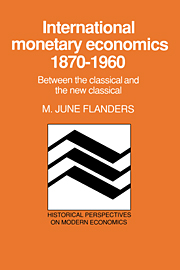Book contents
- Frontmatter
- Contents
- Preface
- 1 Preliminaries
- 2 Stream P
- 3 The beginnings of the neoclassical tradition
- 4 The locus classicus of the neoclassical position
- 5 The Macmillan Committee
- 6 A second diversion: Keynes and the Macmillan Committee
- 7 The anti-neoclassicals
- 8 Indian currency and finance: a tract on monetary reform
- 9 A treatise on money
- 10 Late Keynes: towards Bretton Woods
- 11 The crisis writers
- 3 Stream F
- 4 The confluence
- Ex post
- Bibliography
- Index
10 - Late Keynes: towards Bretton Woods
Published online by Cambridge University Press: 12 October 2009
- Frontmatter
- Contents
- Preface
- 1 Preliminaries
- 2 Stream P
- 3 The beginnings of the neoclassical tradition
- 4 The locus classicus of the neoclassical position
- 5 The Macmillan Committee
- 6 A second diversion: Keynes and the Macmillan Committee
- 7 The anti-neoclassicals
- 8 Indian currency and finance: a tract on monetary reform
- 9 A treatise on money
- 10 Late Keynes: towards Bretton Woods
- 11 The crisis writers
- 3 Stream F
- 4 The confluence
- Ex post
- Bibliography
- Index
Summary
What became known as the keynesian theory of international payments was not, to my knowledge, ever spelled out by Keynes. The marginal propensity to import, and then the multiplier, began to appear in the late 1930s and early 1940s, associated with the names of Harrod (1933), Machlup (1939, 1943), Metzler (1942a, 1942b), Neisser and Modigliani (1953), Paish (1936), and others. A detailed account of these is presented in Chapters 14 and 15 on “the keynesians.” The full-blown integration of keynesian macroeconomic theory with endogenous capital mobility, monetary changes, and some notion of balance of payments equilibrium (even of a short- or medium-run nature) did not appear until the 1950s, with Meade, Mundell, Fleming, and, with great qualification, Metzler, whom I discuss in Chapter 16.
Keynes himself, after the Treatise and the Macmillan Committee testimony, which were roughly coeval, wrote nothing of importance on international economics except for the proposals and correspondence regarding the postwar monetary plans. These, however, constitute a major body of work expressing his views on the international monetary system and the problems he thought were likely to arise in the postwar period. While they are less formally expressed, more diffuse, and more “politically” oriented than the earlier writings I have discussed, they do reveal an analytical stance which is highly recognizable and worth exploring.
In the letters and drafts (and redrafts) of plans for the postwar monetary system (Keynes 1940–4 [1980]) several themes are prevalent throughout.
- Type
- Chapter
- Information
- International Monetary Economics, 1870–1960Between the Classical and the New Classical, pp. 186 - 206Publisher: Cambridge University PressPrint publication year: 1990



